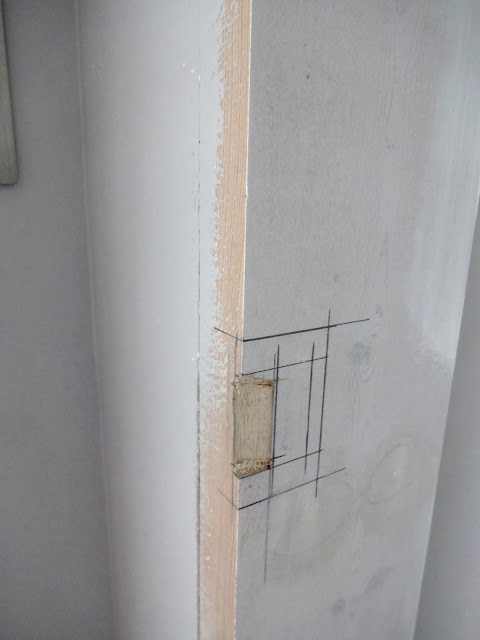Using the chisel method would not have been too bad on unpainted, solid wood doors, but once again our decision to order pre-painted doors unfortunately made everything a lot more difficult.
First step was to measure and mark out the door.
Next we drilled into the side of the door to the depth of the latch.
The area to be chiseled out for the latch plate was marked out in pencil...
... then using a mallet and chisel, cut a recess out for the latch plate. This is where having pre-finished doors proved a disadvantage, as it was almost impossible to cut a clean edge without paint chipping off. Even scoring the paint first did not prevent small flakes breaking away. Grr.
It was crucial to get the holes drilled in just the right place. For some reason, the latch manufacturer didn't include any cutting templates with their products, but it was possible to print them off from their website and this proved essential to getting a perfect fit.
The smaller holes had to be in exactly the right place as studs pass through the door and the latch, effectively bolting one door handle to the other. These 'bolt-through' latches are a much better way to secure door handles, as they can't be yanked off by heavy-handed users like the cheaper handles that are just screwed to the face of the door.
As you can see, the latch is quite a nice fit in the door, but that chipped paint was annoying. Luckily we managed to find a good match for the shade of white and were later able to fill and touch-up any paint issues.
The spindle is placed through the latch and the door handles are slotted into place on top. This meant there was no room for any adjustment, so the alignment of the holes for the through-bolts had to be very precise.
Once the two through-bolts were fitted, the door handles were firmly clamped together, but additional screws were still added around the circumference of the handle to add extra security...
... before a cover plate goes on to conceal all those screw heads and make everything look clean and uncluttered.
Some careful filling and touching-in repaired the chipped paint around the latch plate.
Once the latch was fitted, the next step was to fit the strike plate in the door frame. Lining up where this would go was relatively straightforward, as all we had to do was pull the door up to the frame and mark around the latch. From there, we could draw around the strike plate that would be fitted to get an exact pattern.
Holes drilled for the latch bolt.
The chisel work didn't need to be perfect as the strike plate came with a handy little box that fitted underneath to keep everything looking clean.
The little plastic box fits underneath the strike plate...
... and helps finish everything off neatly.
Not bad for a first attempt. The door linings still needed to be filled and painted at this point hence their patchy appearance.
We chose to use different types of latches for the cupboard doors - roller catches would make opening and closing these doors much easier as the handle would not have to be turned.
As with the standard door latches, the first step was to mark out and then drill into the door.
After drilling the holes, we used a chisel to square everything off so that the latch would fit cleanly inside.
Once the hole was large enough to fit the latch, it was possible to insert the body and draw around the latch plate...
... and carefully chisel out a recess so that the whole thing sits flush with the edge of the door.
For the cupboard doors, we only needed to fit handles to the outside...
... as a handle inside the cupboard would be an unnecessary waste of space. (Even if you accidentally shut yourself in the cupboard, the roller latch meant the door just pushes open so no handle would ever be needed).
As before, once the latch was secured in the door, we could line up exactly where the strike plate needed to go and start chiseling out the recess.
The strike plate fitted in place.
Phew! A perfect fit.
For the bathroom doors, we chose to use separate thumb-turn latches. Fitting these meant a lot more cutting and chiselling, but we preferred the finished appearance so it was worth the extra time and effort.
The thumb-turn latch fitted directly below the door handle.
Having a separate latch meant having to fit an additional lock plate in the door lining. Getting the alignment right was crucial, as we wanted the lock to engage cleanly without having to pull or push the door when turning the latch.
Fortunately everything lined up well first time.
Same treatment for the en-suite bathroom. We managed to touch up any chips and scrapes in the paint afterwards.
We tackled the 3 custom-made glass doors last.
Exactly the same treatment as the solid doors.
The holes drilled through the door for the spindle and the through-bolts.
Despite scoring the lines, no matter how carefully we chiselled, the paint still chipped off far too easily.
Latch fitted in place.
We have used brushed stainless steel throughout the house for light fittings and sockets so naturally all the door fittings followed the same theme.
The paint chips around the latch plate after filling. Once painted they will not be so noticeable.










































